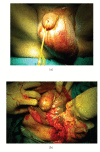Successful Treatment of a Severe Case of Fournier's Gangrene Complicating a Perianal Abscess
- PMID: 21317986
- PMCID: PMC3034918
- DOI: 10.1155/2011/702429
Successful Treatment of a Severe Case of Fournier's Gangrene Complicating a Perianal Abscess
Abstract
A 67-year-old male patient with diabetes mellitus and nephritic syndrome under cortisone treatment was admitted to our hospital with fever and severe perianal pain. Upon physical examination, a perianal abscess was identified. Furthermore, the scrotum was gangrenous with extensive cellulitis of the perineum and left lower abdominal wall. Crepitations between the skin and fascia were palpable. A diagnosis of Fournier's gangrene was made. He was treated with immediate extensive surgical debridement under general anesthesia. The patient received broad-spectrum antibiotics, and repeated extensive debridements were performed until healthy granulation was present in the wound. Due to the fact that his left testicle was severely exposed, it was transpositioned into a subcutaneous pocket in the inner side of the left thigh. He was finally discharged on the 57th postoperative day. Fournier's gangrene is characterized by high mortality rates, ranging from 15% to 50% and is an acute surgical emergency. The mainstay of treatment should be open drainage and early aggressive surgical debridement of all necrotic tissue, followed by broad-spectrum antibiotics therapy.
Figures





References
-
- Eke N. Fournier’s gangrene: a review of 1726 cases. British Journal of Surgery. 2000;87(6):718–728. - PubMed
-
- Yanar H, Taviloglu K, Ertekin C, et al. Fournier’s gangrene: risk factors and strategies for management. World Journal of Surgery. 2006;30(9):1750–1754. - PubMed
-
- Kabay S, Yucel M, Yaylak F, et al. The clinical features of Fournier’s gangrene and the predictivity of the Fournier’s Gangrene Severity Index on the outcomes. International Urology and Nephrology. 2008;40(4):997–1004. - PubMed
-
- Czymek R, Hildebrand P, Kleemann M, et al. New insights into the epidemiology and etiology of Fournier’s gangrene: a review of 33 patients. Infection. 2009;37(4):306–312. - PubMed
-
- Nisbet AA, Thompson IM. Impact of diabetes mellitus on the presentation and outcomes of Fournier’s gangrene. Urology. 2002;60(5):775–779. - PubMed
Publication types
LinkOut - more resources
Full Text Sources

